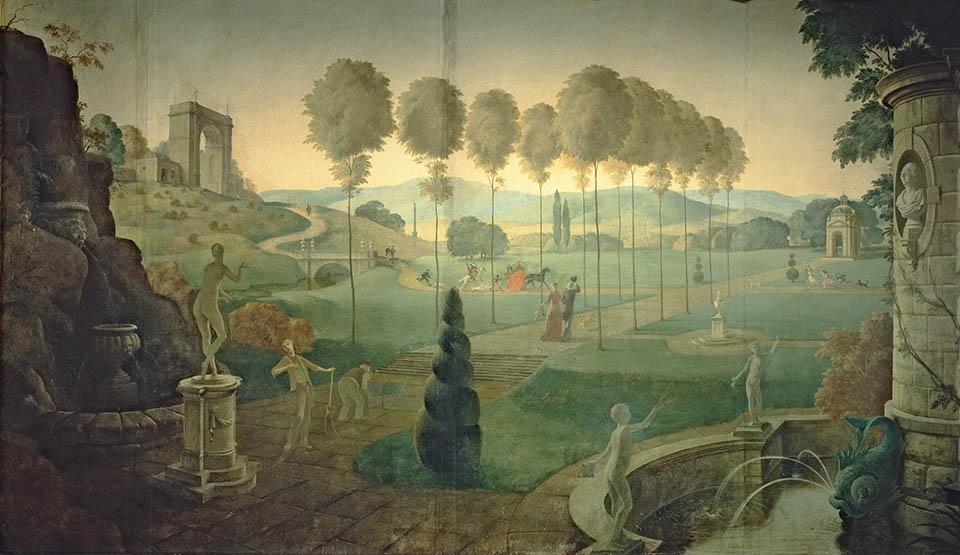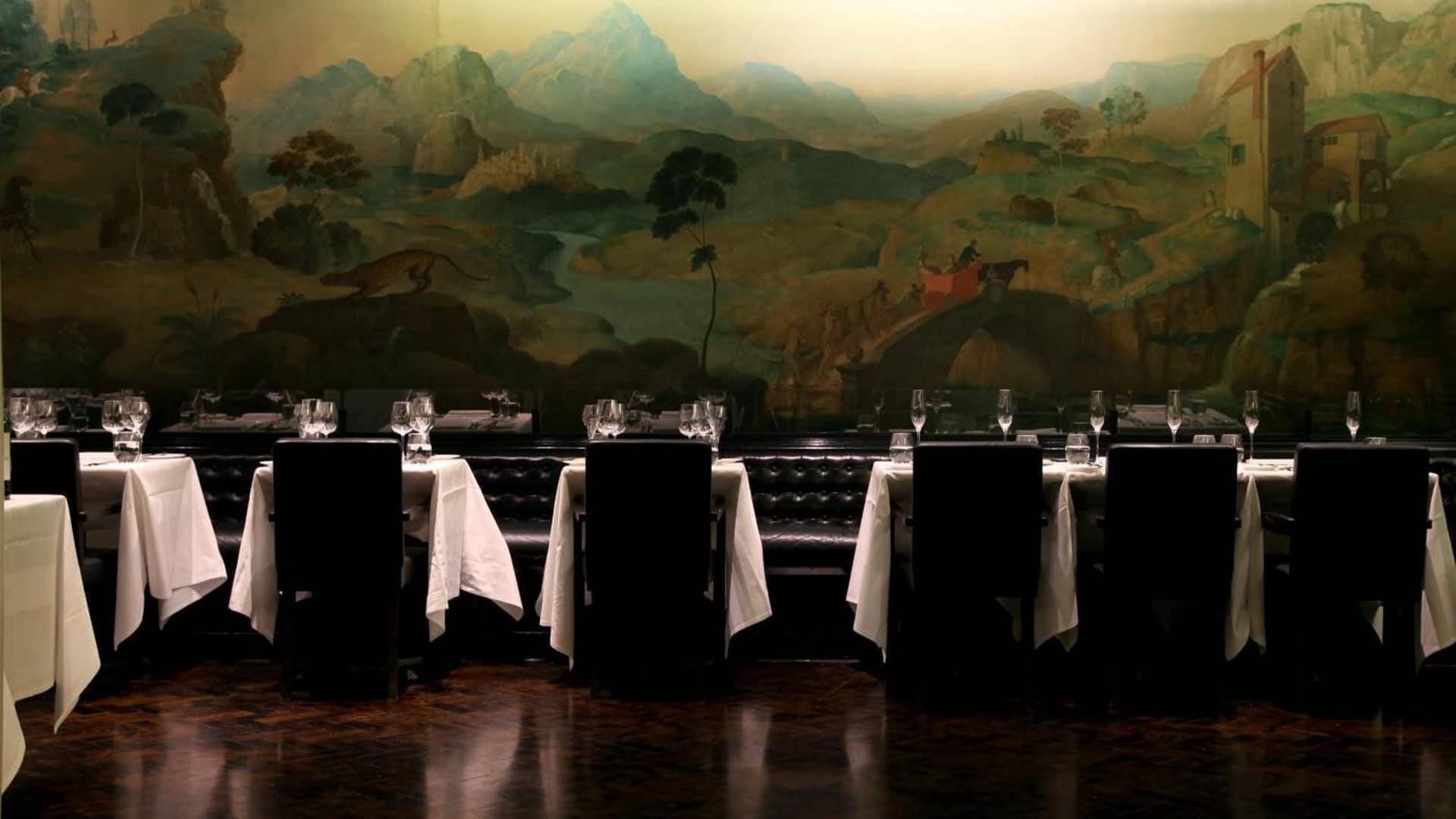Tate Britain’s Rex Whistler restaurant will never reopen the gallery announced yesterday. The restaurant – once known for its excellent and well priced wine list – won’t reopen due to the apparent offensiveness of the mural on its walls. Diners used to be embraced by the mural, The Expedition in Pursuit of Rare Meats, a painting by Rex Whistler, an artist best known for his decorative murals in grand country houses. He was killed in France in 1944 fighting the Nazis, in other words engaging in anti-racist action. When the Tate restaurant first opened in 1927 it was described as ‘the most amusing room in Britain’. It was a favourite spot for BBC political editors to lunch their political contacts.
Not so long ago the Tate was still proud of The Expedition in Pursuit of Rare Meats. As part of Tate Britain’s £45 million rejuvenation in 2013 the mural was extensively restored – of which much was made in the museum’s annual report for that year. The restaurant closed at the start of lockdown and did not reopen – a situation now made permanent.
The reason? In one corner of the mural – a clearly mythical landscape of hunters, nymphs and satyrs – is a black slave boy with a chain round his neck. White Pube, ‘the collaborative identity of Gabrielle de la Puente and Zarina Muhammad under which we write about art, video games and food’, kicked off the fuss about the image during lockdown.

It is not hard to guess the kind of ‘interpretive material’ that will now accompany the mural
The slave boy is not easily spotted – for most people to see it, it has to be pointed out to them. When Labour MP Diane Abbott demanded on Twitter that the restaurant not reopen after lockdown, she stated: ‘I have eaten in Rex Whistler restaurant at Tate Britain. Had no idea famous mural had repellent images of black slaves… Nobody should be eating surrounded by imagery of black slaves’. Abbott was offended even though she had never seen the offending image. But plump, prosperous, middle aged white people might be eating in front of it, making the crime particularly egregious.
Yesterday Tate’s Director Alex Farquharson stated that the Tate had held ‘a series of discussions’ in 2021 about the mural and the outcome of these was a now approved recommendation to the gallery’s trustees that a contemporary work would be commissioned for the room to sit ‘in dialogue’ with the Rex Whistler and that ‘it will… be joined by a new display of interpretative material, which will critically engage with the mural’s history and content, including its racist imagery.’ Only then will the room reopen – although obviously not as a restaurant but rather as a space to reflect upon our collective racism. Only this will give the Tate the opportunity to ‘take responsibility’ for its ‘institutional and cultural history’ and ‘to reflect the values and commitments we hold today’. The Tate will both atone for its past and show how on message it is today.
Farquharson noted that ‘the Rex Whistler mural… has remained static on the walls of a restaurant for almost a century while the museum around it has constantly shifted’. That tends to be the thing with murals; they remain rather static, after all the Sistine Chapel has remained rather static for 550 or so years. The point Farquharson is making is that the Tate is now as an institution all too aware of contemporary concerns and the many ills that the West has alleged served up on the world – yet some of its collection has sadly not kept up with the times.
It is not hard to guess the kind of ‘interpretive material’ that will now accompany the mural. It can already be seen not just with its widely ridiculed signage at Tate’s current Hogarth exhibition but also on displays in its permanent collection.
One of the major inter-war works in the Tate’s collection is Sir Stanley Spencer’s Resurrection, Cookham. Widely regarded as Spencer’s masterpiece, it is a vast canvas depicting the second coming and the dead rising from their graves in the churchyard at Cookham – the artist’s home village, on the Thames 30 miles upriver from the Tate. The racial characteristics of the rising dead have become terribly relevant. A sign has gone up next to the painting:
‘Most of the white people [in the painting] are local friends or specific biblical figures. By contrast, Spencer represents the group of Black people at the centre of the painting in a generalising way. They are not based on people he knew, but on images he saw in National Geographic magazine. Spencer intended to show that all humanity would be included in the resurrection, but in trying to make this point he reinforced racist stereotypes and divisions accepted at the time by most white British people.’
This sign has some immediate oddities. Why is Black deserving of the upper case but white only of the lower case? More importantly Spencer is making a very far from racist statement, indeed a comment on the universality of the Christian message – yet in the Tate’s insistence of making the work relevant it has felt obliged to come up with piffle about racial stereotyping and reinforcing prejudices. It would have been rather difficult to find black faces to paint in 1920s Cookham; if they were present I am sure Spencer would rather have painted them than taking his images from National Geographic.
It seems certain that The Expedition in Pursuit of Rare Meats will suffer greater indignities. But it will sadly not be the last painting to get this treatment from the Tate. Amia Srinivasan, Chichele Professor of Social and Political Theory at All Souls College, University of Oxford, and a co-chair of Rex Whistler mural discussions has stated:
‘Conversations about the mural were open, rigorous, and filled with good-natured but deep disagreement… Could the space be used by artists of colour as a creative site of reappropriation? Or would this unfairly burden them with a problem produced by a historically white institution? One of the few points of consensus was that Tate had to take ownership of its history, and that whatever decision was made had to be an invitation to a broader conversation, not the end of one.’
In other words, much more of Tate Britain’s collection will get the Rex Whistler treatment. It is not something that the world’s great gallery of British art deserves to endure.







Comments